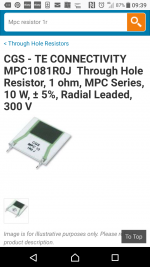So i decided to stick the mjl21193 and 94's in. I set it up at 1.5A bias and let it warm up for an hour. I can tell you now these were easier to adjust then the sankens!
after setting adjusting everything i played music for another hour, there definitely more volume and a different sound. Those temperatures went up though hitting almost 70 degrees! You couldn't touch the heatsinks, so stuck the fan on and it brought it way back down.
What is a safe operating temperature generally? that i can use and sustain without issues?
anyway hooked up the scope to measure the watts.
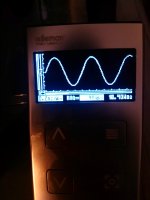
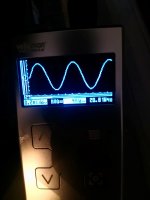
i just dont get it maybe my PSU just cant handle this type of load.
I get 10wrms at 8ohm and 20wrms at 4ohm before clipping.
Now when i run it at 0.6A (same process, wait for an hour, adjust, wait again read adjust then test).
I get more power?
This time i measured 12wrms at 8ohm and 24wrms at 4ohm!
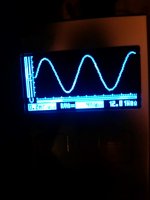
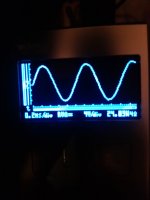
But to me it sounds better at a higher bias, maybe im imagining it and my analytical brain tells me more power is better!
Who knows, i think i have to find a balance between 0.6 and 1.5A.
Good thing is i'm learning and listening.
after setting adjusting everything i played music for another hour, there definitely more volume and a different sound. Those temperatures went up though hitting almost 70 degrees! You couldn't touch the heatsinks, so stuck the fan on and it brought it way back down.
What is a safe operating temperature generally? that i can use and sustain without issues?
anyway hooked up the scope to measure the watts.


i just dont get it maybe my PSU just cant handle this type of load.
I get 10wrms at 8ohm and 20wrms at 4ohm before clipping.
Now when i run it at 0.6A (same process, wait for an hour, adjust, wait again read adjust then test).
I get more power?
This time i measured 12wrms at 8ohm and 24wrms at 4ohm!


But to me it sounds better at a higher bias, maybe im imagining it and my analytical brain tells me more power is better!
Who knows, i think i have to find a balance between 0.6 and 1.5A.
Good thing is i'm learning and listening.
Member
Joined 2009
Paid Member
The 'rule' I follow is that I should be able to keep my hand on the heatsink, otherwise it's too hot. Cooler is usually better but this often means a longer warm-up time from power-on. Good thermal contact between power device and the heatsink is crucial of course. My only functional Class A amplifier is not a Le Monstre, but I put lots of heatsink into play and it never gets hot, just nice and comfy.
thoughts on these?
https://uk.farnell.com/allegro-sanken/2sc3264/transistor-npn-mt-200/dp/1192133
either way have a look on here, this is where i purchase most of my components, looking to try a few more trannies before i decide what i like and make permanent.
https://uk.farnell.com/allegro-sanken/2sc3264/transistor-npn-mt-200/dp/1192133
either way have a look on here, this is where i purchase most of my components, looking to try a few more trannies before i decide what i like and make permanent.
So i decided to stick the mjl21193 and 94's in. I set it up at 1.5A bias and let it warm up for an hour. I can tell you now these were easier to adjust then the sankens!
after setting adjusting everything i played music for another hour, there definitely more volume and a different sound. Those temperatures went up though hitting almost 70 degrees! You couldn't touch the heatsinks, so stuck the fan on and it brought it way back down.
What is a safe operating temperature generally? that i can use and sustain without issues?
anyway hooked up the scope to measure the watts.
View attachment 705899
View attachment 705900
i just dont get it maybe my PSU just cant handle this type of load.
I get 10wrms at 8ohm and 20wrms at 4ohm before clipping.
Now when i run it at 0.6A (same process, wait for an hour, adjust, wait again read adjust then test).
I get more power?
This time i measured 12wrms at 8ohm and 24wrms at 4ohm!
View attachment 705904
View attachment 705903
But to me it sounds better at a higher bias, maybe im imagining it and my analytical brain tells me more power is better!
Who knows, i think i have to find a balance between 0.6 and 1.5A.
Good thing is i'm learning and listening.
Hi Vishalk,
Your maximun power reduces with 1.5A bias because your supply rail voltage drops due to the higher Quiescent current.
Sottomano is correct and the are Sankens out there which work very well.
Look for low Cob. Or close to the original parameters.
There are also Onsemi devices which are quite good.
I would say build it to what sounds best for you.
-Dan
If you ever see signs of stabilityproblems I would first throw out those crappy 1 ohm resistors you've used. They're inductive types and could cause oscilations in the circuit. Better types are the classic MPC-things (the "white blocks"), Dale MRA, Vishay NS or some even use the blue Panasonic-parts with 3 or 5 watts.
Nfsgame thing is those arcol resistors can take a great deal of heat, when I went over 1A they would get extremely warm, at 1.5A water would boil on them, after bolting them to the heat sink they were good to go. Those ceramic resistors are free air cooling wondering if I would need 20W which are massive things.
But I'll take the advice, maybe something as simple as that will make a difference.
But I'll take the advice, maybe something as simple as that will make a difference.
Can you or anyone else recommend their choice of transistors they use?
It has nowadays become a matter of availability.
The common-emitter predriver is an important feature, but it is much more difficult to implement properly than the Darlington pair.
To solve the NPN-PNP mismatch and unavailability problem, I would consider the circlotron option.
I would stick to a big nonmetallic carbon (based) resistor.
Well I like simple circuits as it's about all my knowledge and experience will take me. I would like to get this working as best as I can so I can learn and experience the sound and the difference transistor, bias settings have an effect on the overall performance and sound produced.
With the diy hiraga crew on here I have quickly learnt stuff I knew nothing about and now have a semi working hiraga style le monstre.
I would have to research and see the pros and cons of what you suggest as I know nothing about it.
But open to ideas, have you built one of these and yourself used a circlotron topology.
With the diy hiraga crew on here I have quickly learnt stuff I knew nothing about and now have a semi working hiraga style le monstre.
I would have to research and see the pros and cons of what you suggest as I know nothing about it.
But open to ideas, have you built one of these and yourself used a circlotron topology.
I strongly suggest you stay with this circuit and refine it.Well I like simple circuits as it's about all my knowledge and experience will take me. [...]
Changing to noninductive resistors is certainly a good thing.
The non-perfect match of NPN and PNP is not a huge issue. The Sanken or OnSemis that have been mentioned are ok and not worse than what has been suggested by Hiraga decades ago.
Its however of utmost importance that the amp is stable with bias and not oscillating.
I'm going to have to Google what you wrote N1! All I want is a link to some suitable transistors I can buy and use. Can't find carbon resistors at 10w, ceramic all day.
No need for carbon. Metal film / foil is good (to me way superior to carbon, but that is of course debatable, just not with me).
A short search at the Farnell site gave me these resistors:
OHMITE TNP10SA1R00FE, not cheap but not crazy expensive either.
They are non inductive, as they are not wirewound. Attach a Heatsink, however.
Again, your first steps must be made based on and improving your engineering knowledge. Try out the fancy things later.
Second channel working! refining and getting it right.
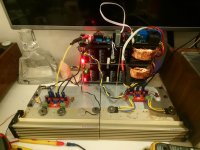
Finally the new driver arrived today so i was able to solder it in and get the amplifier working again! We now have both channels working
One has the sankens in and the other has the MJL's.
One thing to note, is the dc offset affected by temperature rise?
I just want to clarify how to setup the bias and dc offset.
1. When everything is cold i switch the amplifier on and adjust the bias till i get around 0.6v. Then i adjust the dc offset which also affects my bias, i generally play and fiddle with each potentiometer until everything is level and the offset is at zero, to be stable generally means i have 0.61v and 0.63v (is that due to the transistors not being exactly matched?)
2. Leave for 1 hour come back and check bias and dc offset, check and adjust as necessary.
3. Play some tunes for an hour, recheck and adjust?
Now when i've done all this and everything is stable and the temperature doesn't move its all singing and working well.
Now when the next day when its at room temperature and been off, if i switch it on and check my dc offset its not at zero, but when the amp starts warming up its starts to slowly moves down zero as at heats?
Is that correct, sometimes its the same with the bias, and also is it me or when its warm it really starts to sound so much better.
It's like i have to switch it on, leave it for to warm up then play my music.
Basically im asking people methods of setting up so i can do the same then know i can leave it and its good to go.

Finally the new driver arrived today so i was able to solder it in and get the amplifier working again! We now have both channels working
One has the sankens in and the other has the MJL's.
One thing to note, is the dc offset affected by temperature rise?
I just want to clarify how to setup the bias and dc offset.
1. When everything is cold i switch the amplifier on and adjust the bias till i get around 0.6v. Then i adjust the dc offset which also affects my bias, i generally play and fiddle with each potentiometer until everything is level and the offset is at zero, to be stable generally means i have 0.61v and 0.63v (is that due to the transistors not being exactly matched?)
2. Leave for 1 hour come back and check bias and dc offset, check and adjust as necessary.
3. Play some tunes for an hour, recheck and adjust?
Now when i've done all this and everything is stable and the temperature doesn't move its all singing and working well.
Now when the next day when its at room temperature and been off, if i switch it on and check my dc offset its not at zero, but when the amp starts warming up its starts to slowly moves down zero as at heats?
Is that correct, sometimes its the same with the bias, and also is it me or when its warm it really starts to sound so much better.
It's like i have to switch it on, leave it for to warm up then play my music.
Basically im asking people methods of setting up so i can do the same then know i can leave it and its good to go.
Last edited:
I strongly suggest you stay with this circuit and refine it.
Changing to noninductive resistors is certainly a good thing.
The non-perfect match of NPN and PNP is not a huge issue. The Sanken or OnSemis that have been mentioned are ok and not worse than what has been suggested by Hiraga decades ago.
Its however of utmost importance that the amp is stable with bias and not oscillating.
Agreed sottomano, my plan is to refine it and no when and how its stable, can i use my scope or DMM to check if it's oscillating?
Thanks for the link on the resistors i found them cheaper on mouser! So i will order them.
https://uk.farnell.com/bi-technolog...4?MER=bn_level5_5NP_EngagementRecSingleItem_1
might give these a go aswell.
The thing is i don't just want "ok" transistors, i want proven and tested transistors that perform well with this circuit that others have recognised.
Last edited:
How much the DC offset?
Of course, you set up the DC offset at industrial warm.
I had the same issue with my LeMonstre, even the bias moved at warm up.
If you have 1V DC at cold that is not a problem as long as your speaker's protection does not kick in.
Is not possible to put together your heatsinks to create some type of tunnel for your fan, that way would be much more effective. You can buy 5W metal film resistors and carbon films also.
I would buy 2R and use 2PC to get 1R 10W. Did you ever tried plate resistors like KOA etc. to me those acceptable also.
Of course, you set up the DC offset at industrial warm.
I had the same issue with my LeMonstre, even the bias moved at warm up.
If you have 1V DC at cold that is not a problem as long as your speaker's protection does not kick in.
Is not possible to put together your heatsinks to create some type of tunnel for your fan, that way would be much more effective. You can buy 5W metal film resistors and carbon films also.
I would buy 2R and use 2PC to get 1R 10W. Did you ever tried plate resistors like KOA etc. to me those acceptable also.
- Home
- Amplifiers
- Solid State
- Hiraga "Le Monstre"
